The Northern Naturalist #4
Autumn Butterflies, Ten Tips for Finding Butterflies, Review of The Butterfly Watchers Handbook, and News and Notes
Autumn Butterflies
Photo by Ian Parker on Unsplash
I stretched out my big, pink hand, and the tiny, blue butterfly landed right in the middle of my palm and started licking up salt and sweat. It had come down the trail toward me, fluttering like a knuckleball. I stuck my hand out, and it stopped for a snack!
Photo by David Clode on Unsplash
This had a remarkable effect on the group of hikers with me. I was leading a guided naturalist’s hike for the Superior Hiking Trail Association, and we had a full day ahead. I had a mental list of tidbits to spread out over the day—singing Black-throated Blue Warblers and Golden-crowned Kinglets, blooming Sarsaparilla, Clintonia berries, and a bunch more. Having a butterly come directly to me apparently certified my expert status instantly, and this group of hikers maintained their interest through the whole hike.
I would like to be able to say that the animals of the forest flock about me like the butterflies in the old Disney Snow White movie, but it is unfortunately not so. I have had other insects land on me, but it’s more likely mosquitoes and black flies, not butterflies. While I have had butterflies land on me in the past enough to make me hold out my hand as I did that day, my reputation as a “butterfly whisperer” was built on not much.
Openart.ai
Still, it was a helpful mindset for my hike, and we had a great time. As we neared our destination one of the hikers was enthusing about all the things we had seen and heard, and she asked, “So, what is your degree in?” When I told her, “English and French,” she said, “So, you mean anybody could do this?” I had to admit, “Yes, technically anybody could,” but I couldn’t help mentioning my years of learning and traipsing about the woods to prepare me!
All these years later, that butterfly sighting remains in my memory, and I have witnessed the joy and interest of many people when they see any butterfly. This is particularly true in the fall.
We rightly associate butterflies with summer. That’s when most of them are flying, the temperatures are conducive to movement for cold-blooded animals, and their food-plants are blooming. So, when the flowers are diminished, the nights are cold and the leaves begin to fall, it seems especially remarkable to spot a butterfly.
Some species, however, you might call “autumn specialists.” Some are migrating, like the monarchs drifting past hawk watch sites, while others fly in the fall before hibernating. Here are a few examples (I could have used quite a few different species instead.) of showy butterflies to watch for in autumn:
Monarchs (Daraus plexippus) are famous for their epic migratory flights to and from wintering grounds in Mexico. While you’re out watching for hawks, keep your eyes open for Monarchs (or vice versa!). Robert Michael Pyle, who wrote the book I review below, also wrote an interesting book about Monarchs (Chasing Monarchs: Migrating with the Butterflies of Passage, Yale University Press, 2014). In it, he details his discoveries about the western migration routes of Monarchs. You might also see Viceroy (Limenitis archippus), which can look quite similar, but is smaller and has a black vein that runs across the upperwings, perpendicular to the black veins that both species have from front to back on the upperwings.
Photo of Monarch by Jack-t on Unsplash
Photo of Monarch by Britt Gaiser on Unsplash
Photo of Viceroy by J Dean on Unsplash. Note that the black band is not always so obvious.
Mourning Cloak (Nymphalis antiopia) is named for its dark brown upper wings, which can look brown to black, depending on the lighting. The yellow margins of their wings is visible at a distance, and if you can get close enough, you can see the beautiful blue dots inside the yellow margins.
Mourning Cloaks are the quintessential spring and fall butterfly. They hibernate over the winter, and emerge relatively early in the spring, when they are one of the first species out and about in our area. Then they go dormant (aestivate) for the summer and re-emerge to migrate in the fall. One of their earliest English names was “Grand Surprise,” which certainly fits.
istock.com/Karl Ander Adami
Photo of Mourning Cloak underwing istock.com/Richard Stephen
Question Mark (Polygonia interrogationis) is one of the anglewings, butterflies whose wings narrow from top to bottom, creating an angular, “reaching-out” appearance. Question Marks prefer dung and rotting fruit for food and only use flowers when they can’t find their preferred food. You might think that this is where the name comes from (as in, “?!”), but actually it’s from a tiny, double, white mark on the underwing, which might look like a question mark to you. Dung and fruit are more available during cold weather than flowers are, so these butterflies are able to fly later in the year than flower-preferrers.
istock.com/Kyle Robinson
Question Mark Underwing by Paul Crook on Unsplash
Eastern Comma (Polygonia c-album) is another anglewing. There are multiple comma species, but this is our most common. Commas are some of the most widespread species on earth. The comma population in Britain crashed in the nineteenth century due to the reduction in hop-farming, and I wonder if the current increase in hop-crops will boost the population of commas. The comma is named for a tiny, vivid, white mark on the underside of the wing.
Photos of Eastern Comma by Erik Karits on Unsplash
Red Admiral (Vanessa atalanta) As with all of the butterflies I’m mentioning here, this is a widespread species. We see them in fall, because they have two broods, and the later one pushes adult flying later into the fall. One of their archaic names was “Red Admirable,” which I like better. They are less skittish than most butterflies when approached, so you might be able to get a closer look.
Photo by Ian Kellsall on Unsplash
Photo of underwing of Red Admiral by Ulrike Leone on Unsplash
Of course, odd circumstances can lead to odd sightings. As I write this, I am on the Door Peninsula in Wisconsin, and yesterday I saw a fritillary in a patch of echinacea (I didn’t have my binoculars, so I don’t know which species.) My local fritillaries are usually most active early in the season, but this one was patrolling in the sunshine here in late August.
Keep an eye out for “summer” phenomena in fall. It pays off in delights like these butterflies—at least until the snow flies.
Ten Tips for Finding Butterflies
1 - Season
Once temperatures are above freezing in the spring, some butterflies will be out. If the temperature is below freezing, they will not be out, unless you’re in some kind of micro-climate where the temperature is warmer—say, in the vicinity of a sun-baked rock wall. In my neck of the woods, late April through October is usual, with the peak in June and July (but, of course, see the above article about autumn butterflies!).
2 - Temperature
They’re cold-blooded, so if we get a cold snap in the warm season, they may not fly much. I once discussed cold-snaps with a friend who lived near Brimson, Minnesota, about an hour’s drive north of Lake Superior. He grew tomatoes in a greenhouse, and he told me that most years, July was the only month without frost, and it happened sometimes in July too. The butterflies have to fly sometime, so watch for sunny, warm days in the midst of colder periods.
3 - Range
Like all organisms, butterflies inhabit ranges of the map that are congenial to them. Since they fly, like birds, they can be blown astray, but that’s rare. If you find something that seems out-of-range, double-check your identification. It’s always fun to find something rare, but your search will be enhanced by knowing what’s likely in your neighborhood.
4 - Host Plants
Important parts of their life-cycle are spent on or near particular plants, so if you know the plants, you can look for specific species around them. Most field guides provide at least general information about the host plants of species.
5 - Habitat
In a way, this is the same as #4, because the plants are what determine what butterflies want and need, but the lives of the plants and the butterflies are intertwined with the soil, the topography, and the climate, all of which are larger in scope than specific species. Some butterflies are found in particular woodlands; others, in meadows or bogs. Within family groups, each species will have specific preferences. Experienced observers learn which areas have the right feel (and specific signs) for specific species.
6 - Over Time
In this issue, I have emphasized the flying adult stage in the lives of butterflies, but one can also find eggs, larvae (caterpillars), and pupae (cocoons) on the appropriate host plants. In Robert Michael Pyle’s Mariposa Road: the First Butterfly Big Year, he told of visiting Minnesota in winter, where he was able to add to his list by finding butterfly eggs in the dead of winter.
7 - Plant Plants
Gardening for butterflies brings the butterflies to you. There are many information resources for this, and in season, a well-designed garden may be full of butterflies.
8 - Hilltopping
Butterflies who are seeking mates often fly to the highest point in an area, a phenomenon called “hilltopping.” You can take advantage of this to see butterflies. Choose the highest accessible point in your area. A hillside with steep, open slopes may be best. (In Duluth, I have had good luck on Thompson Hill, the bluff situated at the west end of the city, near Spirit Mountain.)
9 - Yuck
Butterflies can often be found on scat, rotting fruit, or other unsavory food sources. I guess I have never tried “staking out” one of these, but it’s worth keeping your eyes open for them on a hike. They glean salts and other minerals from these sources. They do the same at puddles, which can also be good places to look.
10 - Serendipity
Part of the appeal of looking for mobile organisms, like birds and butterflies, is that they can show up anywhere. The points above are hints about how to improve your chances, but the biggest tip is probably just to have the mindset that one might find a butterfly anywhere or in odd circumstances. This approach is guaranteed to produce more sightings!
Review of Robert Michael Pyle, Handbook for Butterfly Watchers, Houghton Mifflin Harcourt, 1992, 280 pp. Under $10 used.
When I first read this book in the mid-nineties, it was a revelation to me. In it, Robert Michael Pyle gives a detailed overview of an entire realm of activity—butterfly-watching. His overview is literate, detailed, scientifically-sound, and, above all, shows his affection for butterflies and the natural world.
Butterfly-watching is a great adjunct to birding. Say you find yourself in a grassland in western Minnesota as mid-day approaches. The bird-singing has died down and won’t pick up again until evening. As things heat up, however, the butterflies, who were mostly dormant in the morning cool, begin to fly, and you can chase them for a few hours. Because butterfly species are so connected with particular species of plants, it is endlessly interesting to learn how they interact, along with learning the names of both bugs and plants. If you like to sleep in, and don’t mind being out in the sun at mid-day, butterfly watching may be the outdoor activity for you!
The book is so well-written that when I have taught classes on interpretive writing, I have often quoted directly from it. It’s clear and detailed-enough, and the details are pertinent. Pyle was part of the movement from butterflying as a catch-pin-and-collect endeavor to butterfly watching, and this book includes a chapter considering this.
There are 19 chapters, each an essay considering some aspect of watching butterflies. For book-lovers, there is an appendix listing many fine butterfly books. Obviously, such a list that is over 30 years old is missing a lot of great newer books, but I find this list still helpful. It can lead you to some classics that have dropped out of circulation, and anything that is still in print is well worth investigating. It is not a field guide, so if you’re new to butterflies, you might want a field guide at your side while you read.
The book is out-of-print, and as I looked back at it for this review, it struck me that non-fiction books now are rarely as text-intensive as this one. There are some good illustrations, but it’s mostly text. Pyle has written many books, including a field guide, novels, and poetry, in addition to other nature-related non-fiction. I have read many of them, and they are all well-written. Probably his most well-known book focuses on another organism, Where Bigfoot Walks: Crossing the Dark Divide (Counterpoint Press, August 15, 2017, 464 pp. ISBN: 978-1619029378), which has been made into a feature film, The Dark Divide. It’s not a book that seeks a hard answer on the existence of Bigfoot.
I once attended a signing Pyle did for Mariposa Road: the First Butterfly Big Year (Houghton Mifflin Harcourt, 2010, 576 pages, ISBN: 061894593). The term “Big Year” originated with birders who were trying to see as many species as possible in one year. In Pyle’s case, he looked for butterflies instead. I’ll be writing more about Big Days and Big Years in the future. When he signed my copy of his book, I gave him a copy of one of my books, and a couple of months later, I received a long, detailed thank you note and appreciation of the book. I cherish it, and it was kind of him to write it.
Pyle also co-edited the voluminous butterfly writings of the great novelist, Vladimir Nabokov, who was obsessed with butterflies (Nabokov’s Butterflies: Unpublished and Collected Writings, Beacon Press, January 1, 2000, 783 pages, ISBN: 978-0807085400). Along with all of this, Pyle founded the Xerces Society for Invertebrate Conservation (xerces.org).
If you are interested in butterflies, or even if seeking them out is a new idea to you, I think you’ll enjoy Robert Michael Pyle’s Handbook for Butterfly Watchers.
News and Notes
If you’re enjoying your reading here, one of my books is still in print and available at
https://thephotonaturalist.com/product/woodpeckers-of-north-america/
Woodpeckers of the North: A Naturalist’s Handbook includes profiles of all North American species, along with sidebars about their fascinating lives, and spectacular photos taken by Paul Bannick. Stone Ridge Press, 2014.
The annual migration of Common Nighthawks (Cordeilles minor) down the North Shore of Lake Superior is an annual phenomenon well worth experiencing. As with most natural occurrences, it can’t be pinned down to a specific date, but at some point after August 20th, they will come. From that date through almost the end of the month, there will be at least a trickle of birds flying, especially close to dusk. Their migration is subject to the same factors as the raptor migration I wrote about last month—don’t look on rainy days with easterly winds. Every once in a while, there will be a mega-flight of thousands of birds on one evening. It’s something to see.
They come all at once because they eat only cold-blooded invertebrate prey, and they need to be well south before the frosts come.
Sparky Stensaas, The Photonaturalist, has some nice video about the bizarre sound nighthawks make in flight at 2:07 minutes in this video:
Here’s an extended quotation that I like from Robert Michael Pyle, taken from the book reviewed above (Handbook for Butterfly Watchers, p. 1):
“Few other subjects in the realm of nature or craft offer the aesthetic pleasure to be gained from observing butterflies. In a jaded world, butterfly watching furnishes a simple and refreshing pathway to fascination. Not an escape, but a fresh kind of connection with reality, butterfly watching provides a new nature alternative.
Seeking out and observing butterflies gives one a unique window on the world. One cannot become a butterfly lover without at the same time growing sensitive to the animals, plants, soils, landforms, weather, and climate—and the habitats they all make up together. So the watcher of butterflies soon becomes a botanist, a geologist, a reader of clouds—in effect, a general naturalist.”
There’s no denying it’s late summer now, and at moments, it feels like fall. Many bird species are well into migration. Outside the place I am staying in Wisconsin, the birds change over every day.
One bird that is especially active now is American Goldfinch (Spinus tristis), which needs to be active, since it requires thistle down for its nests. Unlike most birds that begin to attempt to nest as soon as the weather allows, goldfinches have to wait, and this time of year, you’ll hear them a lot, maybe see them with young, and you have a chance of seeing them flying around with thistle down in their bills.
Thank you so much for reading my newsletter. It means a lot to me. Please let me know if you have ideas you’d like to see in the newsletter, and especially if you have problems with how it functions. I’m continuing to learn about the best ways to set things up.





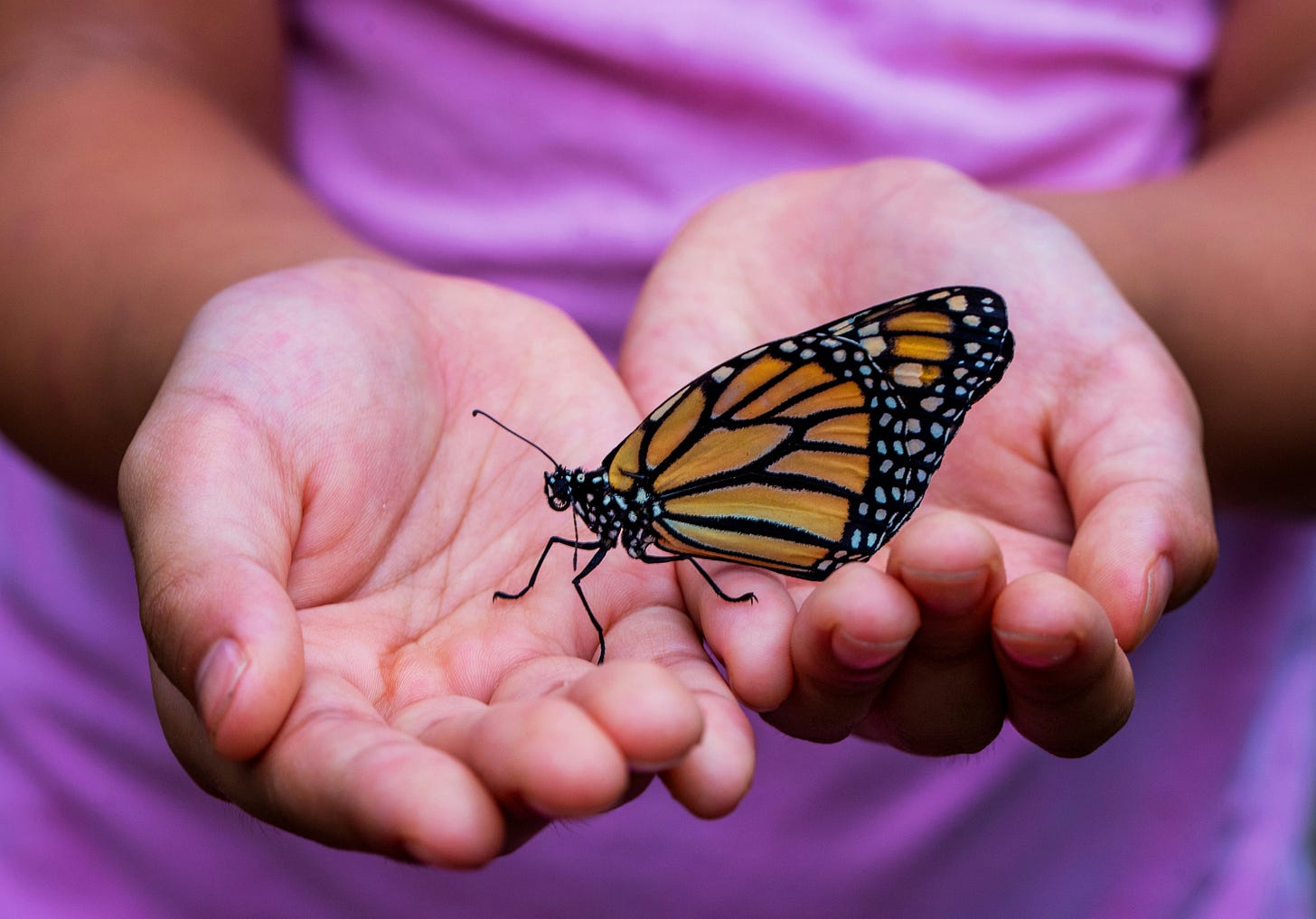


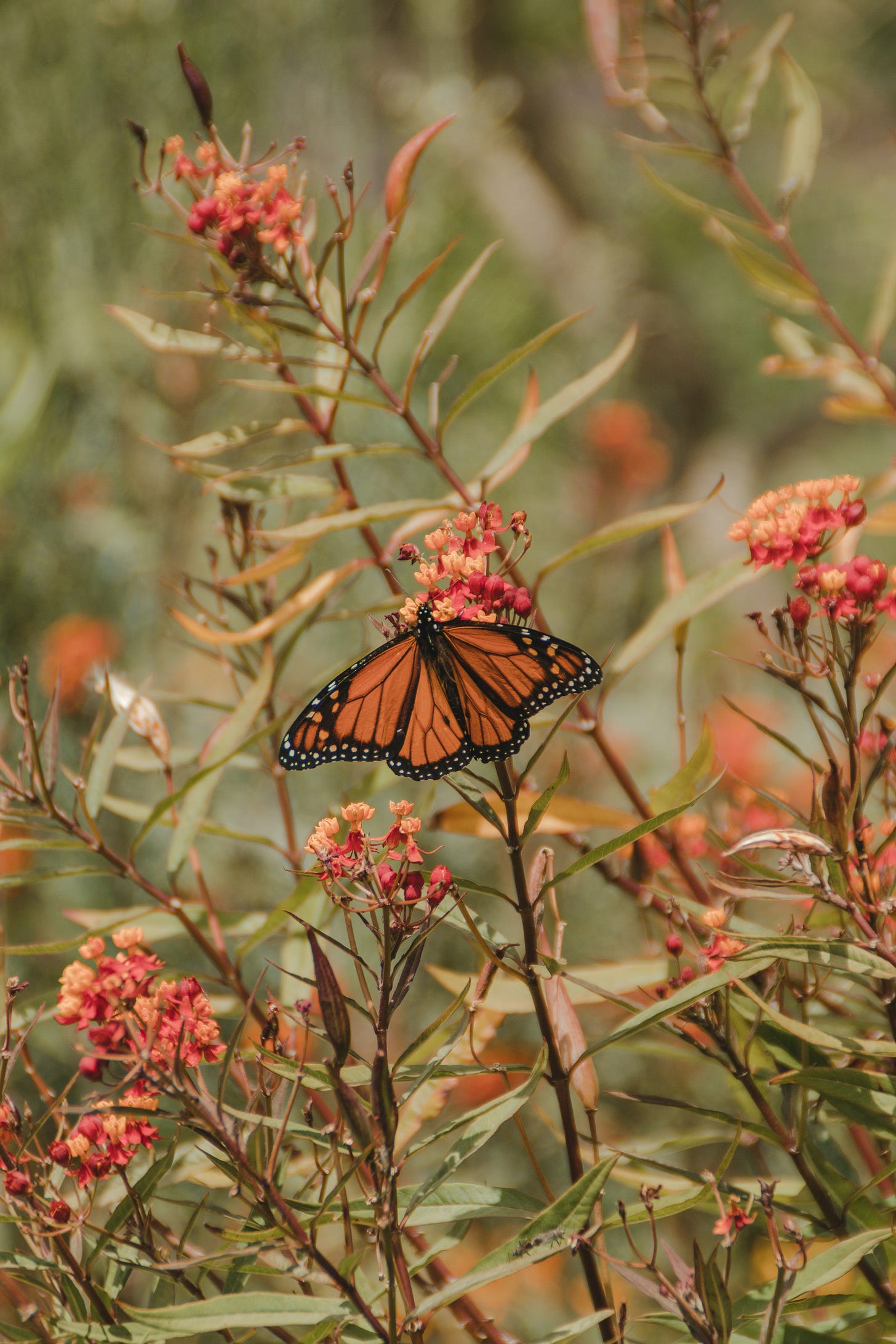



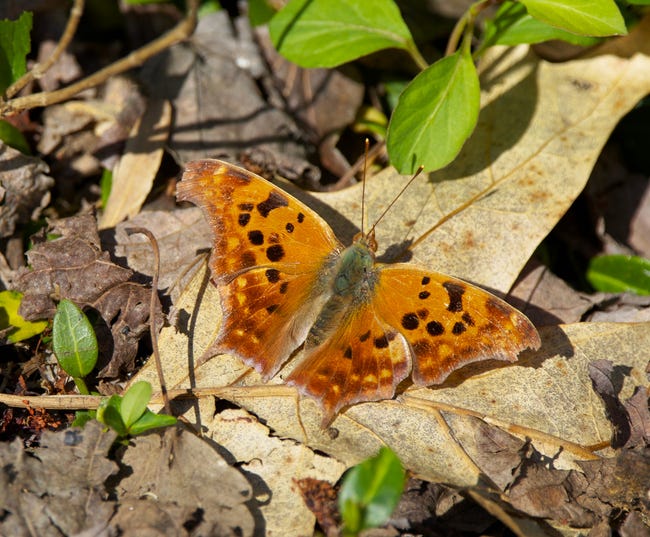


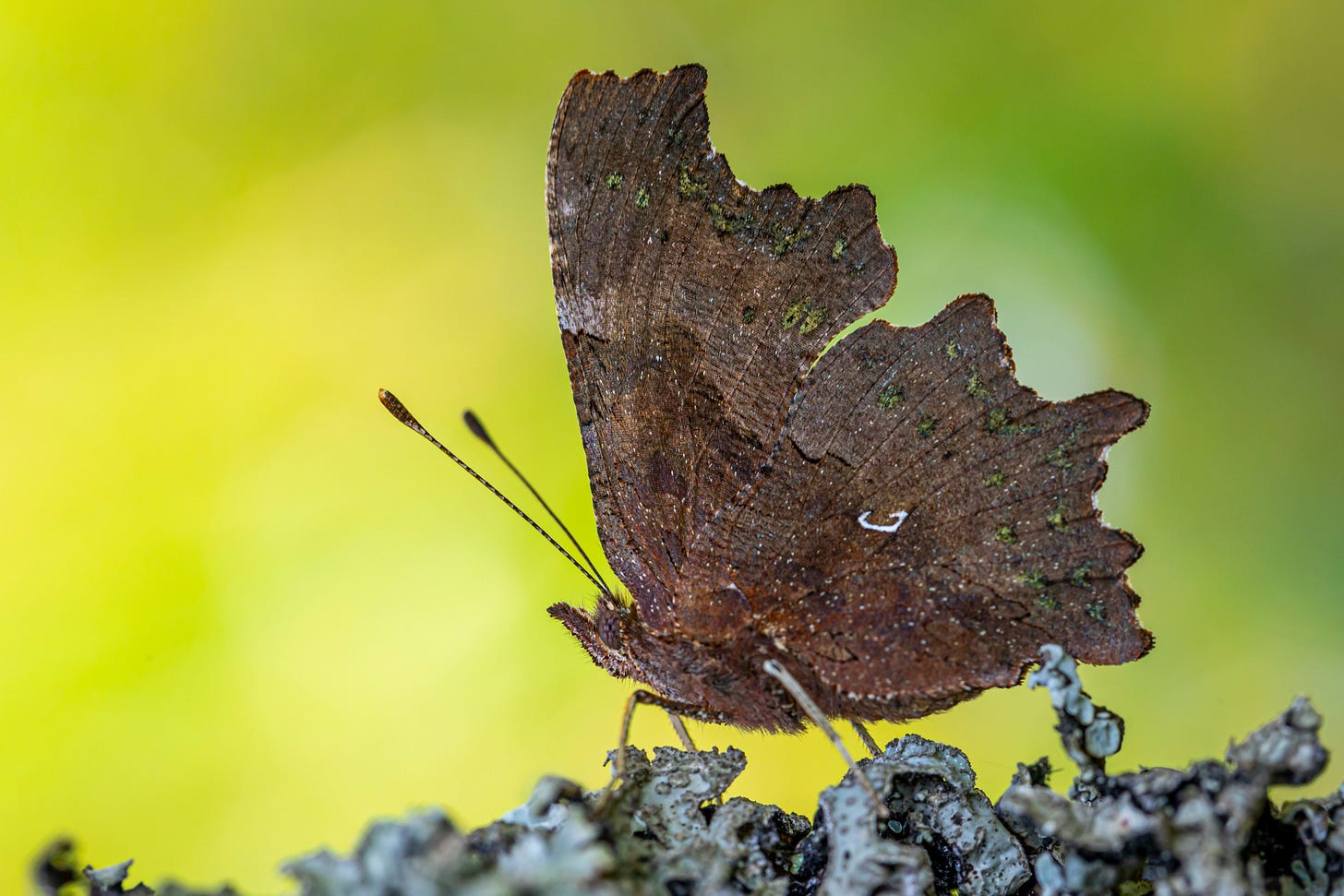
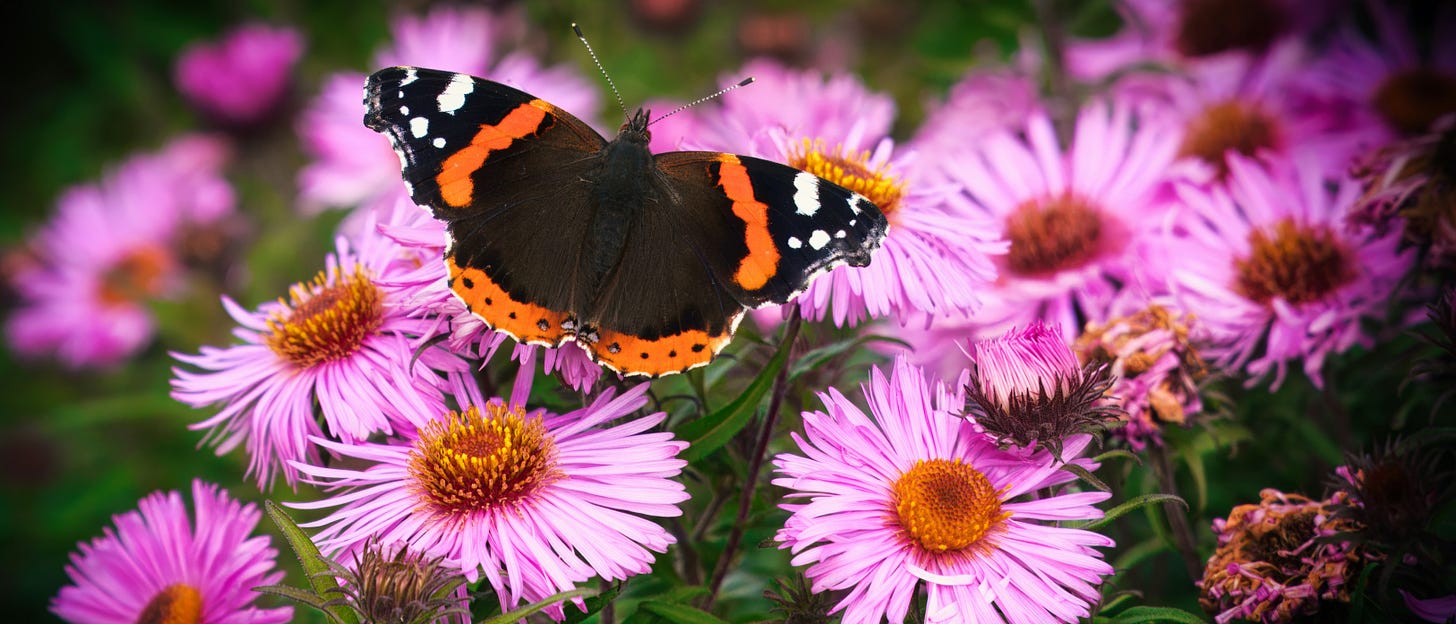
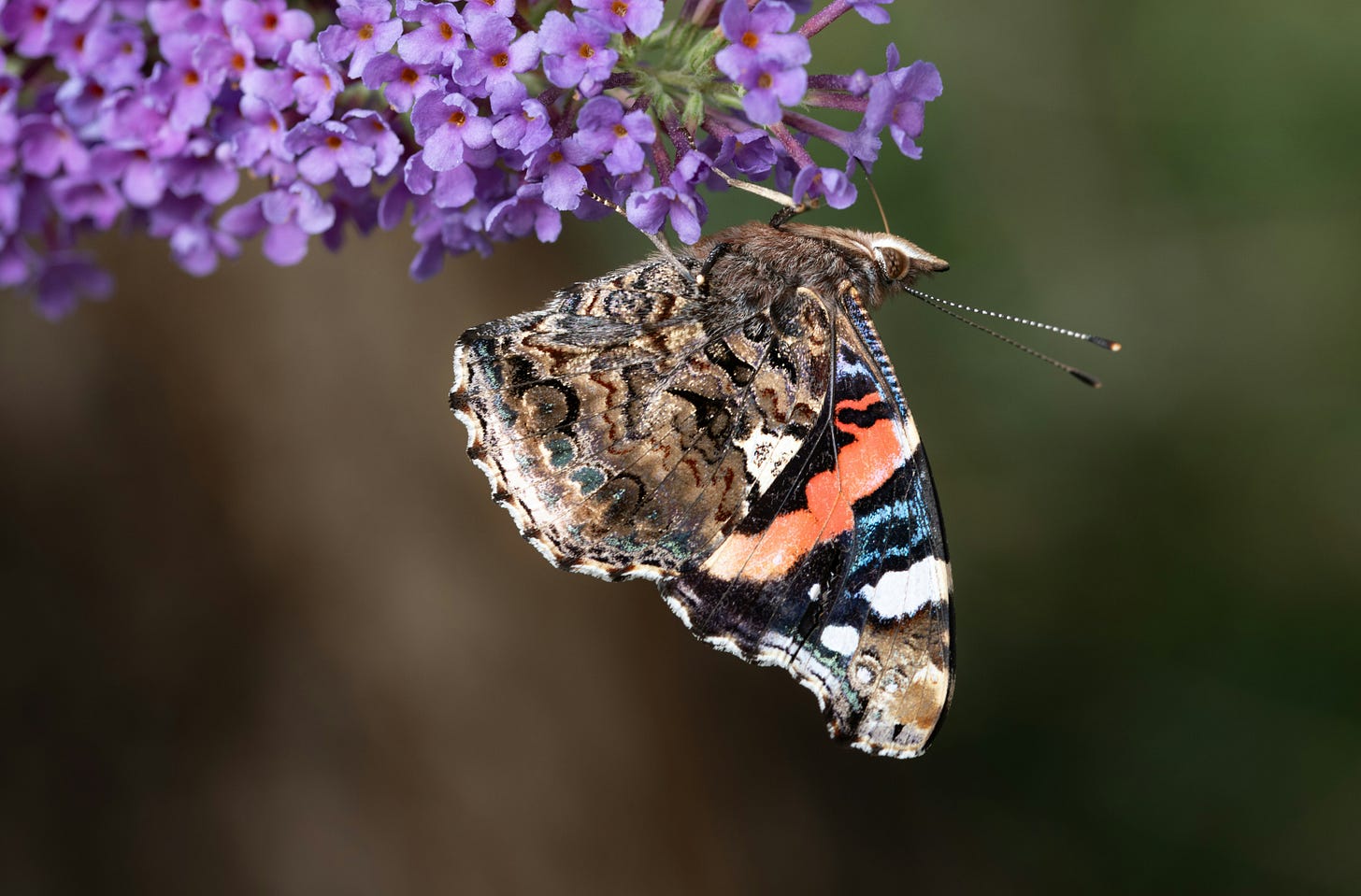



What a great edition, Dave! Watching butterflies flit and float creates such a sense of serenity in me. We’ll be watching throughout the autumn weeks. I also loved Sparky’s video! When my wife, Kim, and I lived in Walnut Grove, we could hear the sharp sound of the Common Nighthawk beginning at dusk. There was a very tall light pole right outside our bedroom window where they would perch and screech. It was hard getting to sleep with that sound some nights, but still very cool knowing that they were nighthawks.